Description
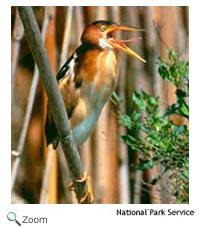 The least bittern is a very small wading bird that is 11-14 inches in length with a wingspan of 16-18 inches. It has a dark brown or black crown and back, an orange-brown neck and sides, a white chin, and an orange and white striped throat and breast. It has white stripes on its sides and yellow-gold patches on its wings that are visible when it is in flight. It has a pointed yellow bill, yellow eyes, and long legs that are green in the front and yellow in the back. Males and females look alike, but the female is a little duller in color. The least bittern is a very small wading bird that is 11-14 inches in length with a wingspan of 16-18 inches. It has a dark brown or black crown and back, an orange-brown neck and sides, a white chin, and an orange and white striped throat and breast. It has white stripes on its sides and yellow-gold patches on its wings that are visible when it is in flight. It has a pointed yellow bill, yellow eyes, and long legs that are green in the front and yellow in the back. Males and females look alike, but the female is a little duller in color.
Range 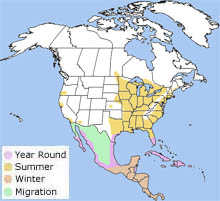 The least bittern breeds in the central and eastern United States. It winters in Florida, Mexico, and Central and South America. The least bittern breeds in the central and eastern United States. It winters in Florida, Mexico, and Central and South America.
Habitat 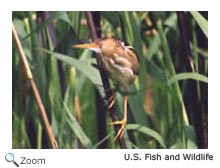 The least bittern is found in freshwater or brackish marshes with tall grasses, cattails, and reeds. The least bittern is found in freshwater or brackish marshes with tall grasses, cattails, and reeds.
| |
Diet
The least bittern eats small fish, eels, small snakes, salamanders, insects, frogs, and crayfish.
Life Cycle
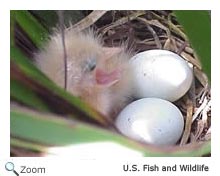 The male and female least bittern build a platform nest of reeds, cattails, sedges, and other plant matter a foot or so above the water. The female lays 2-7 eggs at a rate of one egg per day. Both parents incubate the eggs and care for the young. The eggs hatch in 24-28 days and the chicks leave the nest 1-2 weeks after hatching. The male and female least bittern build a platform nest of reeds, cattails, sedges, and other plant matter a foot or so above the water. The female lays 2-7 eggs at a rate of one egg per day. Both parents incubate the eggs and care for the young. The eggs hatch in 24-28 days and the chicks leave the nest 1-2 weeks after hatching.
Behavior 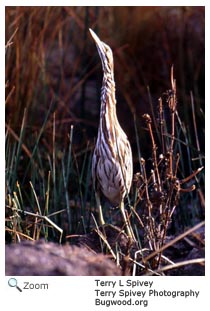 The least bittern, like the American bittern, relies camouflage coloration to protect it from predators. It spends most of its time hidden in the reeds. It seldom flies, preferring to stay hidden in the tall marsh grasses. The least bittern, like the American bittern, relies camouflage coloration to protect it from predators. It spends most of its time hidden in the reeds. It seldom flies, preferring to stay hidden in the tall marsh grasses.
When startled, it sometimes
stands motionless and points its bill straight up in the air in an attempt to blend in with the tall marsh vegetation.
It is a good climber and often perches on tall marsh grasses, reeds, or low tree branches.
|

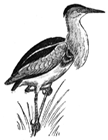

 The least bittern breeds in the central and eastern United States. It winters in Florida, Mexico, and Central and South America.
The least bittern breeds in the central and eastern United States. It winters in Florida, Mexico, and Central and South America.


